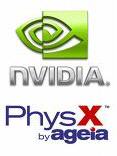nVIDIA to acquire AGEIA Technologies

GPU makers nVIDIA have announced that it intends to purchase physics middleware company AGEIA Technologies for an undisclosed sum.

Note: When I refer to physics I mean hardware-based physics, unless I specifically mention software-based enhancements.
One thing's for sure - the era of an independent physics vendor is now over, and that might not be a bad thing.
[poll id=264]
While I can't question the talent that existed over at AGEIA, the company had problems pushing the idea of a separate card dedicated to physics process to both the games industry and gamers alike. Game support was patch at best and reviews mixed. Back in December of last year I called PhysX, along with DirectX 10, a gaming dead end, and I still stand by those words.
So, what does this acquisition mean? Well, first off, re-read the press release and notice that cash isn't mentioned once. That's an indication that this sale could have been more like a lifeline thrown to AGEIA by nVIDIA, especially given how poor PPU card sales must have been. My guess is that this sale came in at well below the $150 million mark.
Where will this take physics? In one of two directions (and guess what, neither direction will rely on a separate card). In the short term I expect existing AGEIA PPUs to be supported as normal, and it's quite possible that nVIDIA, given its close ties to the games industry, might be able to rustle up more support ... maybe (if you own an AGEIA card, don't hold your breath on this one). But ultimately nVIDIA have got to be looking at getting physics support either into the GPU, or, and this might be a far more tactical move, into the chipset. The GeForce 8200 integrated graphics chipset could be an indication of where nVIDIA might head with this. Getting support for physics on the chipset could give the company a huge advantage over both AMD and Intel and act as a persuasion lever to get games companies on board.
Alternatively, but less likely, nVIDIA has little to no interest in physics and simply wants to have access to AGEIA technology to improve GPU performance. In which case, gaming physics is pretty much dead in the water.
So is this bad news for AMD and ATi? No, not really. While I doubt that nVIDIA will play nicely with ATi and create some sort of open standard/industry standard physics platform, physics is still a tough sell to the games industry who still prefer to keep things as simple as possible and code for the lowest common denominator. Even where games already support physics (such as Ghost Recon and Unreal Tournament 3), gamers aren't kicking doors down to use this technology.
For proprietary physics processing to become mainstream it's going to take a real industry push, and the only company with the muscle to do that in my opinion is Microsoft. Until DirectX offers physics support, it'll remain nothing more than a curiosity. Game makers will continue to strive for realism, but this will be done by using propriatory code and relying on the growing number of CPU cores available.
Thoughts?